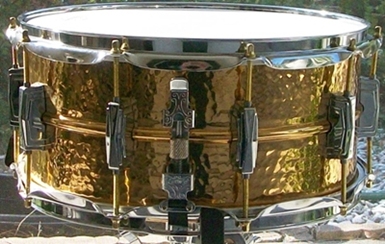I have a personal theory that preferences are often based on the first snare drum a drummer owns. I prefer wood snare drums, and it's probably because my first drum kit in 1964 came with a wood snare drum. The sonic characteristics of our first snare drums tend to imprint us. Wood snare drums are typically warmer than metal, and have tonal qualities that a metal snare drum cannot deliver. Metal, and especially brass, tends to project more, sound brighter, and - when tuned a certain way - has a "honk" that appeals to many drummers.
Certain snare drums, however, have sonic characteristics of both shell types. The Slingerland copper snare drum I discussed in my last post has wood-like sound qualities. Part of the reason is the copper shell, which gives the drum a softer, almost diffused tone.
There is another class of metal shell that possesses the same qualities: hammered metal. I own two, both made from different types of metal, that would fool many in a blindfold test.
The first is my Ludwig 6.5x14 hammered bronze snare drum:

That is the snare drum that induced me to try metal sell snare drums. The hammering dried out the sound sufficiently to give it a distinct wood tone, and the bronze shell contributed to the tone and sensitivity, making it ideal for brushwork. In fact, it is an extraordinarily sensitive drum considering the shell depth. At first I wasn't sure if it was the bronze shell or the hammering that imparted the sonic qualities I found so desirable. I became convinced after I acquired another hammered shell snare drum - a 5x14 hammered Supraphonic:

Not only is the depth more shallow, but the shell is made from Ludalloy (Ludwig's term for chrome plated aluminum.)
Like the bronze shell model, the hammered Ludalloy model is drier than a standard Ludalloy Supraphonic, and has wood-line tone.
To truly ensure that it's the hammering and not the shell material I tested out a Ludwig 5x14 hammered brass Black Beauty. The test was apples-to-apples against the Ludalloy hammered Supraphonic in that the depths were identical. Result: same dry, woody quality as the other hammered shell snare drums. It was actually a surprise because brass is a much brighter sounding metal when used for drum shells.
The conclusion is if you want a snare drum that shares some of the most important characteristics of both wood and metal, then a hammered shell snare drum (or one with a copper shell) may be the best solution. I've used Ludwig snare drums as examples because I own and have first hand experience with them. Most major drum companies offer hammered shell snare drums, mainly made from brass, including Gretsch, Pacific, Peace and Worldmax. They are worth a look if you are seeking a versatile snare drum that has tone with a bit more projection.
No comments:
Post a Comment